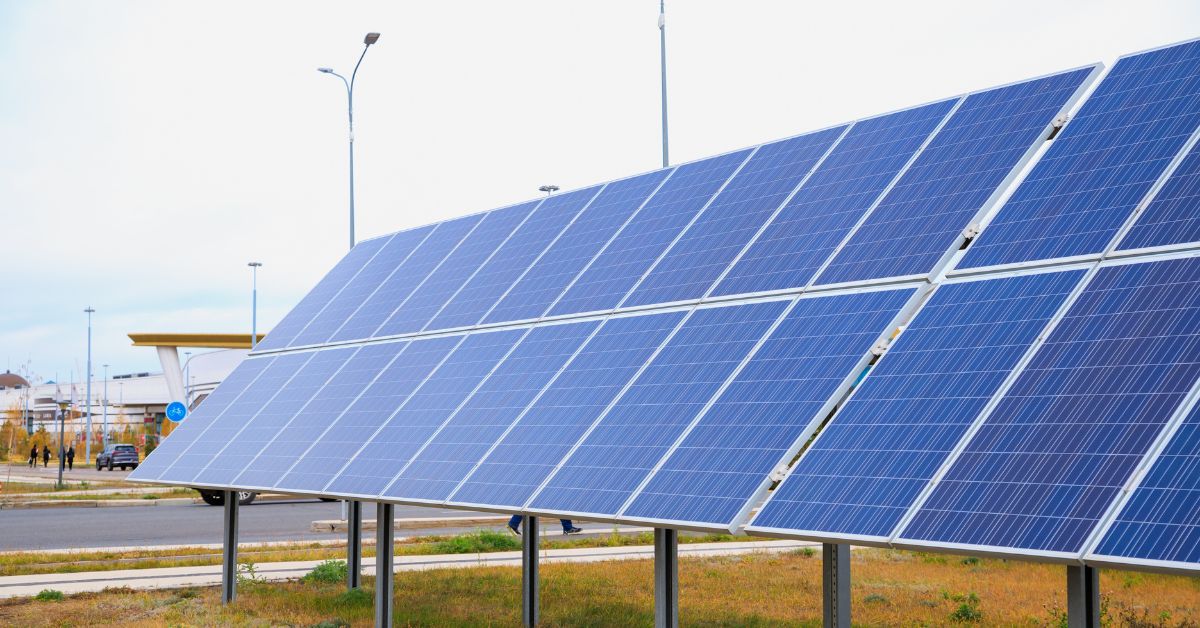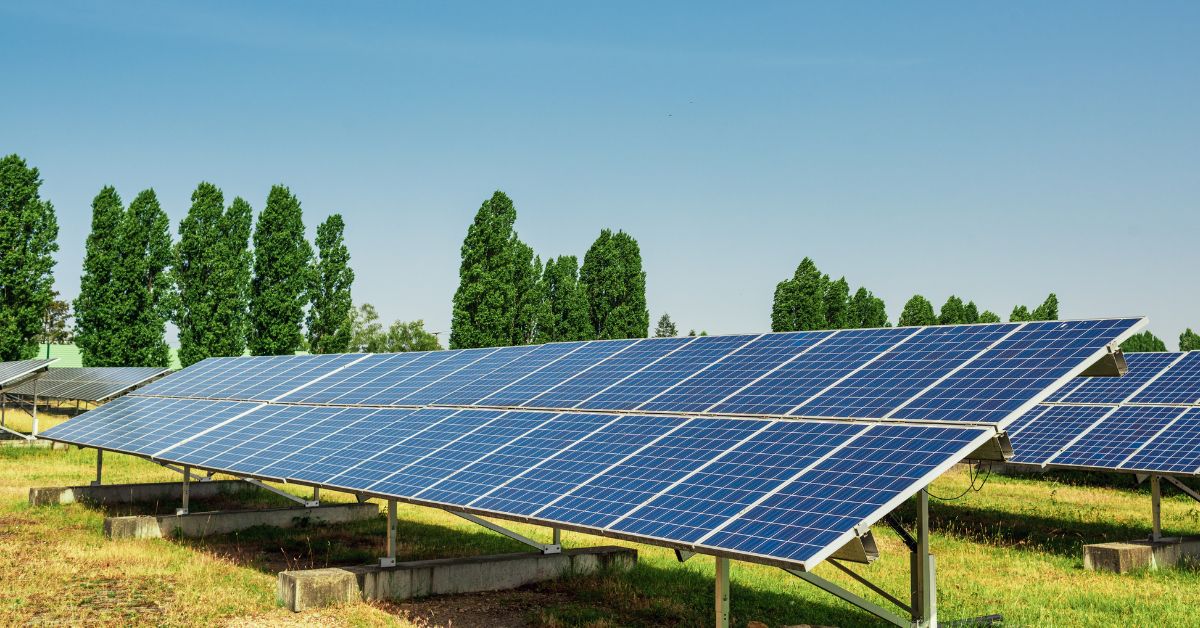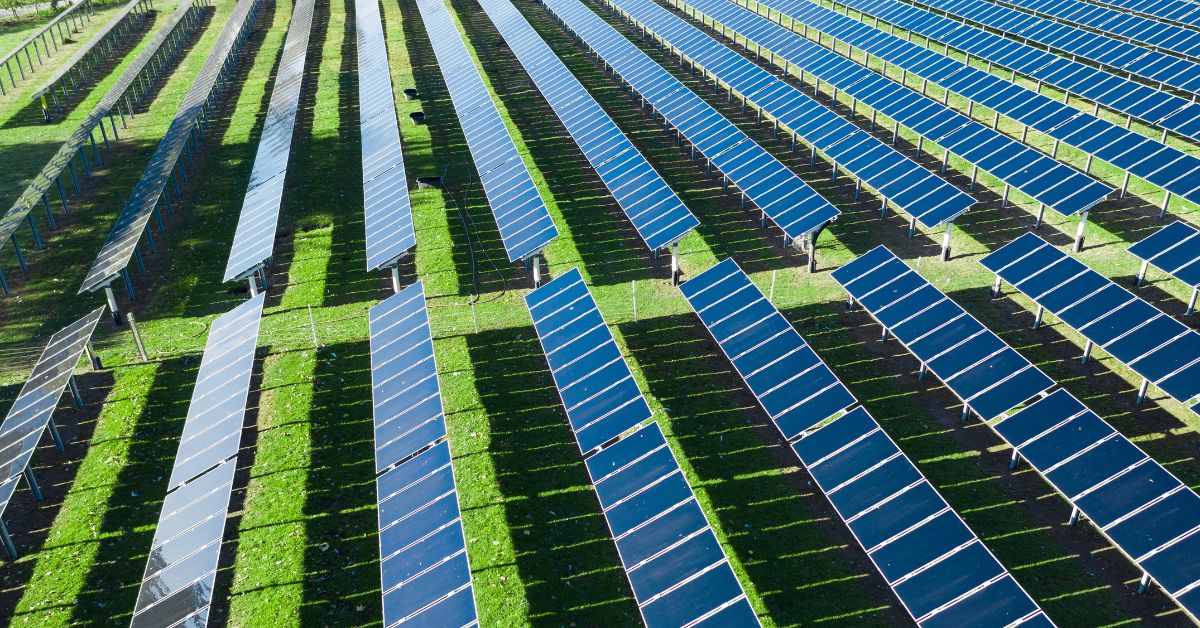What is On Ground Solar System and How Does It Work
Know the details about What is On Ground Solar System and How Does It Work, An on-ground solar system, or ground-mounted solar system, is an array of solar panels installed directly on the ground rather than rooftops. These systems harness sunlight to generate electricity using photovoltaic (PV) panels, which convert sunlight into direct current (DC) electricity.
An inverter then converts this DC power into alternating current (AC) for household or commercial use. Ground-mounted systems are versatile, allowing for optimal panel placement to maximize sun exposure, and can be installed on adjustable racks for seasonal efficiency. Commonly used in larger-scale applications, they’re ideal for those with ample land, making solar energy accessible beyond rooftop installations.
Table of Contents
What is On Ground Solar System and How Does It Work?
In an era where the demand for renewable energy is becoming increasingly urgent, solar power has emerged as one of the most promising solutions to reduce our dependence on fossil fuels. As governments and organizations strive to reduce greenhouse gas emissions and combat climate change, solar energy systems have taken center stage in the conversation. Among the various types of solar installations available, the on-ground solar system has gained significant traction due to its versatility and scalability.
In this article, we’ll explore what an on-ground solar system is, how it works, its components, benefits, challenges, and its role in the future of renewable energy.
What is an On-Ground Solar System?
An on-ground solar system, often referred to as a ground-mounted solar system, consists of photovoltaic (PV) panels that are installed directly on the ground, as opposed to being mounted on rooftops or integrated into buildings. These solar panels capture sunlight and convert it into electricity, providing a clean, renewable source of energy for residential, commercial, and industrial purposes.
Unlike rooftop solar systems, on-ground solar systems are typically larger and can be installed in a variety of terrains, from flat agricultural lands to uneven or sloped fields. They are commonly used for utility-scale solar farms, large commercial projects, and residential setups where enough land is available.
How Does an On-Ground Solar System Work?
The operation of an on-ground solar system is based on the principles of photovoltaics. The system utilizes the photovoltaic effect to generate electricity from sunlight. Here’s a step-by-step breakdown of how it works:

a) Sunlight Hits the Solar Panels
The solar panels are made of semiconductor materials, most commonly silicon. When sunlight (composed of photons) strikes the surface of the solar panels, it excites the electrons in the semiconductor material.
b) Electric Current is Generated
The excited electrons create a flow of electric current, also known as direct current (DC). Each panel generates DC electricity, but this form of electricity is not suitable for direct use in homes or businesses.
c) Inverters Convert DC to AC
The DC electricity generated by the solar panels is sent to an inverter (or a series of inverters). The inverter’s job is to convert the DC into alternating current (AC), which is the standard form of electricity used by most appliances and devices.
d) Electricity is Sent to the Grid or Storage
Once the electricity is converted into AC, it can either be sent to the power grid, used to power a building directly, or stored in batteries for later use. If the system is grid-tied, any excess energy that is not used can be fed back into the electrical grid, and the system owner may receive credits or payments from the utility company through a process known as net metering.
e) Monitoring and Maintenance
Many modern on-ground solar systems come equipped with monitoring systems that allow the owner or operator to track the performance of the solar array in real time. Regular maintenance, including cleaning the panels and inspecting the wiring, ensures optimal performance.
Components of an On-Ground Solar System
To understand how an on-ground solar system operates, it’s important to be familiar with its main components:
a) Solar Panels
The core component of any solar power system, solar panels are made of photovoltaic cells that capture sunlight and convert it into electricity. They are typically composed of monocrystalline or polycrystalline silicon.
- Monocrystalline Panels: Known for their high efficiency and longevity, these panels are made from single-crystal silicon and perform well in limited space.
- Polycrystalline Panels: These panels are less expensive but generally have lower efficiency compared to monocrystalline panels. They are made from silicon fragments melted together.
b) Mounting System
The mounting system is crucial for securing the solar panels to the ground. In on-ground solar systems, racks or frames are used to tilt the panels at an optimal angle to capture the most sunlight. These systems can be:
- Fixed Tilt: The panels are installed at a fixed angle, usually based on the latitude of the location to maximize sunlight capture year-round.
- Tracking System: More advanced systems use tracking mechanisms to move the panels throughout the day, following the sun’s path across the sky. Single-axis and dual-axis trackers are common types, with dual-axis providing the highest efficiency.
c) Inverters
Inverters convert the direct current (DC) generated by the solar panels into alternating current (AC) for use in homes, businesses, or for feeding back into the grid. There are three types of inverters:
- String Inverters: These connect multiple panels in a series (called a “string”), which makes them suitable for large systems.
- Microinverters: Installed directly on each solar panel, microinverters optimize the performance of each panel and allow for better performance in areas with partial shading.
- Power Optimizers: A middle-ground solution between string inverters and microinverters, power optimizers are attached to individual panels to maximize their output but still rely on a central string inverter for DC to AC conversion.
d) Electrical Components
These include wiring, junction boxes, disconnect switches, and fuses, all of which are necessary to safely and efficiently transport electricity from the solar panels to the inverter and the grid.
e) Monitoring System
Modern on-ground solar systems often include monitoring equipment that tracks the system’s performance, detecting any issues with individual panels or inverters, and providing data on energy production.
Types of On-Ground Solar Systems
On-ground solar systems come in several different configurations, depending on the specific needs of the site and the energy demands. The three main types include:

a) Fixed-Tilt Ground-Mounted Systems
These systems use a fixed mounting structure, meaning the panels are installed at a set angle. They are simple to install and have lower upfront costs, but they may not be as efficient as tracking systems because they do not follow the sun’s movement.
b) Single-Axis Tracking Systems
In single-axis tracking systems, the solar panels are mounted on a rotating structure that follows the sun from east to west throughout the day. This increases energy capture by 20-30% compared to fixed-tilt systems.
c) Dual-Axis Tracking Systems
Dual-axis tracking systems are even more advanced, allowing the panels to adjust both horizontally and vertically to track the sun’s path more accurately throughout the year. This type of system is typically used in high-efficiency solar farms but comes with higher costs due to its complexity.
Advantages of On-Ground Solar Systems
The widespread adoption of on-ground solar systems is driven by several key advantages, especially for large-scale projects:
a) Scalability
Ground-mounted systems are highly scalable, making them suitable for everything from small residential installations to utility-scale solar farms spanning hundreds of acres.
b) Optimal Sunlight Exposure
Unlike rooftop solar systems, which are often constrained by the orientation or shape of the roof, on-ground systems can be placed in areas that receive optimal sunlight throughout the day.
c) Efficient Cooling
Solar panels tend to lose efficiency as they heat up. Ground-mounted systems, being open to the air, often cool more efficiently than rooftop panels, thereby maintaining better performance.
d) Flexibility in Design
On-ground systems offer flexibility in terms of system design, panel layout, and tracking technology. This flexibility allows engineers to tailor the system to the specific needs of the location, maximizing energy production.
e) Easy Maintenance
Ground-mounted systems are more accessible for maintenance, cleaning, and inspection compared to rooftop installations. This ease of access can lead to longer-lasting systems and reduced maintenance costs.
f) Use of Barren Land
On-ground solar systems can be installed on land that may not be suitable for other uses, such as barren or agricultural land that is not in active use. This maximizes land use without displacing other valuable economic activities.
Challenges of On-Ground Solar Systems
Despite their many advantages, on-ground solar systems also present some challenges:
a) Higher Installation Costs
While on-ground systems offer scalability and efficiency, they also come with higher installation costs compared to rooftop systems due to the need for additional mounting structures, land preparation, and potentially more complex wiring.
b) Land Use
Large-scale on-ground solar installations require significant amounts of land, which can lead to concerns about land use, especially in regions where available land is scarce or highly valuable. However, dual-use approaches like agrivoltaics (combining solar panels with agriculture) can help mitigate these concerns.
c) Permitting and Zoning Regulations
Obtaining the necessary permits for on-ground solar installations can be a time-consuming and complex process. Zoning regulations, environmental impact assessments, and community opposition may also pose challenges to getting a project off the ground.
d) Environmental Impact
While solar energy is considered environmentally friendly, large-scale on-ground solar installations can disrupt local ecosystems, particularly if they are built on previously undeveloped land. However, efforts can be made to mitigate these impacts, such as using land that has already been disturbed or implementing strategies to protect local wildlife.
Applications of On-Ground Solar Systems
On-ground solar systems are used in a variety of settings, from small-scale residential projects to massive utility-scale solar farms. Here are some common applications:

a) Residential Installations
Homeowners with enough land can install ground-mounted solar systems to meet their energy needs, offering an alternative to rooftop installations. This is especially beneficial for properties where roof space is limited or shaded.
b) Commercial and Industrial Projects
Businesses with large plots of land can benefit from ground-mounted solar systems by reducing their reliance on the grid and cutting energy costs. These systems can also enhance a company’s sustainability profile, which can be a competitive advantage in today’s eco-conscious marketplace.
c) Utility-Scale Solar Farms
The largest application of on-ground solar systems is in utility-scale solar farms, where thousands of panels are installed to generate electricity for the grid. These massive installations provide clean energy to entire communities, reducing the need for fossil fuel power plants.
d) Agrivoltaics
A growing trend in solar energy is the combination of solar installations with agriculture, known as agrivoltaics. This approach allows land to be used for both energy production and farming, creating a dual-use solution that benefits both sectors.
The Future of On-Ground Solar Systems
The future of on-ground solar systems looks bright, as advances in technology, falling costs, and the global shift toward renewable energy drive continued growth. Several trends are shaping the future of ground-mounted solar systems:
a) Improved Efficiency
Solar panel efficiency continues to improve, allowing more energy to be generated from a smaller surface area. This trend will make on-ground systems even more cost-effective and reduce the amount of land needed for large-scale projects.
b) Energy Storage Integration
The integration of energy storage solutions, such as lithium-ion batteries, will become increasingly important for on-ground solar systems. Energy storage allows excess electricity generated during sunny periods to be stored and used when the sun is not shining, providing a more stable and reliable source of power.
c) Bifacial Panels
Bifacial solar panels, which capture sunlight on both sides of the panel, are gaining popularity in ground-mounted installations. These panels can increase energy production by capturing sunlight reflected off the ground, further boosting efficiency.
d) Hybrid Systems
Hybrid solar systems that combine on-ground solar with other renewable energy sources, such as wind or biomass, are becoming more common. These systems offer a diversified energy portfolio and can provide more consistent power generation.
FAQs About What is On Ground Solar System and How Does It Work
Q1. What is an on-ground solar system?
An on-ground solar system is a photovoltaic (PV) setup installed on the ground, as opposed to rooftops. It consists of solar panels, inverters, and sometimes battery storage, designed to convert sunlight into electricity.
Q2. How does an on-ground solar system generate electricity?
Solar panels contain photovoltaic cells that absorb sunlight and convert it into direct current (DC) electricity. This DC electricity is then converted into alternating current (AC) by inverters for use in homes and businesses.
Q3. What are the main components of an on-ground solar system?
The main components include solar panels, inverters, mounting structures, wiring, and, optionally, battery storage systems to store excess energy for later use.
Q4. What are the advantages of using an on-ground solar system?
Advantages include greater energy generation potential due to optimal panel placement, flexibility in system size, easier maintenance, and the ability to scale the system as energy needs increase.
Q5. How much space do I need for an on-ground solar system?
The space required depends on the system size and energy needs. Generally, each kilowatt of solar capacity requires about 100 square feet of land, but this can vary based on the specific technology used.
Q6. Can on-ground solar systems be installed in any location?
While on-ground solar systems can be installed in various locations, they perform best in areas with ample sunlight and minimal shading. Local regulations and land use restrictions may also influence site selection.
Q7. What are the installation requirements for an on-ground solar system?
Installation typically requires a flat or gently sloping area, access to sunlight, and compliance with local zoning laws and building codes. A professional assessment can help determine suitability.
Q8. How do I maintain an on-ground solar system?
Maintenance involves regular inspections for debris, dirt, or shading that may reduce efficiency, as well as checking electrical connections and ensuring the inverters are functioning properly. Most systems require minimal maintenance.
Q9. What happens if it rains or snows?
On-ground solar panels are designed to operate efficiently in various weather conditions. Rain can help clean the panels, and they can still generate electricity on cloudy days. However, heavy snow may temporarily reduce energy production until it melts.
Q10. Are there financial incentives for installing an on-ground solar system?
Yes, many governments offer incentives such as tax credits, rebates, and grants for installing solar systems. Additionally, some utility companies provide net metering, allowing you to earn credits for excess energy generated by your system.
On-ground solar systems represent a critical component of the global transition to renewable energy. Their scalability, flexibility, and efficiency make them ideal for a wide range of applications, from residential homes to large utility-scale projects. While challenges such as land use and installation costs remain, advances in technology and innovative land-use strategies are helping to overcome these obstacles.
As solar power continues to grow as a major source of clean energy, on-ground solar systems will play a pivotal role in reducing our dependence on fossil fuels, lowering greenhouse gas emissions, and creating a more sustainable future. Whether you’re a homeowner looking to reduce your energy bills or a business owner seeking to improve your sustainability efforts, on-ground solar systems offer a practical, long-term solution for harnessing the power of the sun.
Click here to learn more about What is On Ground Solar System and How Does It Work
Click here to learn more about Key Features to Look for in Rooftop Solar System Installers

